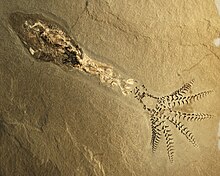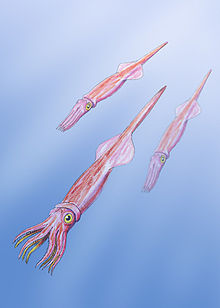箭石类
箭石类动物(学名:Belemnoidea),旧作箭石下纲,是一类已灭绝的海生头足纲动物,生活在泥盆纪至白垩纪之间。箭石在许多方面都与现代的鱿鱼相当接近[1],而且与现代的乌贼关系密切。箭石也拥有墨囊[2],不过它们有10条大约相同长度的触腕,其中并没有特别长的触腕[3]。此外,箭石的内壳远比乌贼发达,由鞘、闭锥以及前甲三部分构成,其中鞘的部位成分为钙质,最容易保存在地层中形成化石。“箭石”一名便是源自于其形如箭镞般的鞘化石。
| 箭石下纲 Belemnoidea | |
|---|---|

| |
| 保存完好的闭箭石(Phragmoteuthis conocauda)化石,显现出完整的外套膜轮廓及触腕 | |
化石
| |
| 科学分类 | |
| 界: | 动物界 Animalia |
| 门: | 软体动物门 Mollusca |
| 纲: | 头足纲 Cephalopoda |
| 亚纲: | 蛸亚纲 Coleoidea |
| 总目: | †箭石总目 Belemnoidea Zittel, 1895 |
| 目 | |

箭石的学名"belemnoid"是来自于希腊文βέλεμνον(belemnon,意指“飞镖或箭头”),以及另一希腊字είδος(eidos,意指“形式”)。[4]
演化历史
编辑箭石类在侏罗纪与白垩纪时数量相当多,所以它们的化石在中生代的海洋岩层中相当丰富,经常伴随着菊石类出现。不过箭石也跟菊石一起在白垩纪末期灭绝了。箭石是由杆石于泥盆纪时期演化而来,从密西西比纪(或早石炭世)至白垩纪末之间的地层中可以发现良好的箭石化石,其他头足类如杆菊石、鹦鹉螺类及棱菊石类等也可发现。
雷石
编辑在数百年前的欧洲,尚未有古生物学概念的时代,当时的英国人认为箭石的化石是雷打到地面而形成的,所以称其为“雷石(Thunderstones)”,成为箭石化石的别称。[5]
分类
编辑- 箭石类动物 Cohort Belemnoidea
- 血箭石目 Hematitida
- 血箭石科 Hematitidae
- 多诺万箭石目 Donovaniconida
- 多诺万箭石科 Donovaniconidae
- 闭箭石目 Phragmoteuthida
- 闭箭石科 Phragmoteuthidae
- 科 Rhiphaeoteuthidae
- 沟箭石目 Aulacocerida
- 箭石目 Belemnitida
- 双箭石目 Diplobelida
- 科 Chondroteuthidae
- 双箭石科 Diplobelidae
- 血箭石目 Hematitida
参见
编辑参考文献
编辑- ^ Thomas E. Yancey, Christopher L. Garvie, Mary Wicksten. The Middle Eocene Belosaepia ungula (Cephalopoda: Coleoida) from Texas: structure, ontogeny and function. Journal of Paleontology. 2010/03, 84 (2): 267–287 [2018-04-02]. ISSN 0022-3360. doi:10.1666/09-018r.1. (原始内容存档于2018-06-12) (英语).
- ^ Lehmann, U. 1981. The Ammonites: Their life and their world. London: Cambridge University Press.
- ^ Peter Doyle, Emma V. Shakides. The Jurassic Belemnite Suborder Belemnotheutina. Palaeontology. 2004-07-01, 47 (4): 983–998 [2018-04-02]. ISSN 1475-4983. doi:10.1111/j.0031-0239.2004.00395.x (英语).
- ^ Webster's New Universal Unabridged Dictionary. 2nd ed. 1979.
- ^ Vendetti, Jan. The Cephalopoda: Squids, octopuses, nautilus, and ammonites. UC Berkeley. 2006 [2013-06-07]. (原始内容存档于2018-01-03).